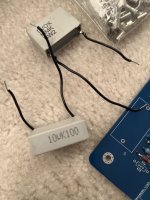There is Class A amplifier with efficiency almost as in Class B here: https://www.diyaudio.com/community/threads/100w-cfa-class-h-classa-classb.394923/#post-7246781
Progress so far and thanks to @Vunce for providing a pair of PCBs along with the soldered SMD stuff. I guess I missed getting the big 10uf film capacitor 🙁 I only have 4.7uf and 3.3uf film caps. Also the specified cap from the BOM 505-DCP4-10/600/10L is currently out of stock in Mouser but I could find this one - https://www.mouser.com/ProductDetail/WIMA/DCP4H151006DD2KSSD?qs=RB4whv9F6rzPtYQ9ZKniqA==

Last edited:
Can I go with 4.7uf or 3.3uf cap here instead of 10uf or maybe I do have those Nichicon green sleeves no polarity caps for temporary testing.
C7 is in parallel with bias voltage source which consists from R16, Q5, Q6, R17 and D1, biased by Q1 CCS and reflected through current mirrors. It provides time constant that prevents that output MOSFETS would pass current immediately after amplifier power on with unlimited fast switch-on.
It also helps keep bias voltage between MOSFET gates constant under fast and large signal changes. It was not chosen for low ESR but for type which introduces minimal distortion. This capacitor is not in the direct signal path, but when aiming for very low distortion, it is reasonable to use best quality parts.
It also helps keep bias voltage between MOSFET gates constant under fast and large signal changes. It was not chosen for low ESR but for type which introduces minimal distortion. This capacitor is not in the direct signal path, but when aiming for very low distortion, it is reasonable to use best quality parts.
Nice progress Manniraj!Progress so far....
The 600V DC link cap is out of stock, so I went with the 800V version.
I used a little goop between the 3503/1381 BJT's and heatsinks, but it’s not required as Tombo mentioned they don't get too hot.
Be sure to connect Signal Gnd, Decoupled Gnd and speaker return all at the psu, otherwise you will see some wonky behavior. (Don't ask me how I know this
 )
)Good luck with your next steps.....
Last edited:
I found few old EVOX 10uf film caps from my earlier pedja IV so planning to use these for now to power the amp.
Attachments
Last edited:
🙁I found few old EVOX 10uf film caps
EVOX MMK capacitors are metallized polyester type. Polyester is dielectric which produces biggest distortion. Check this page:
https://conradhoffman.com/cap_measurements_100606.html
You can use them for start if willing to replace latter.
Thanks @bohrok2610 I guess I got these from eBay many moons ago so wasn't sure if they are real or fake 🙂
@tombo56 I guess I will avoid these and instead either use 4.7uf WIMA or those Nichicon green sleeves.
@tombo56 I guess I will avoid these and instead either use 4.7uf WIMA or those Nichicon green sleeves.
Yes thats the task and hopefully my Antek gets delivered by tomorrow and I can power it up over the weekend 🙂
I hope your PS has enough GND connection points.I can power it up over the weekend 🙂
You need 3 – 4 depending on how is safety connection to chassis made. Signal ground connection is amplifier ground reference for input signal. Connect that to physically middle positioned gnd connection at the PS board. Loudspeaker gnd should be connected next to that gnd point, not at any other point down the gnd connectors array.
Decoupling gnd should be connected next, farthest as possible from former two connections. If you have prasi’s CRC boards, connectors marked as “IN-GND” are also allowed for this.
Safety grounding, probably through NTC resistor, if not connected otherwise, can be connected to any remaining gnd connector.
- Home
- Amplifiers
- Solid State
- Building an ultimate low power class A amplifier – my way


